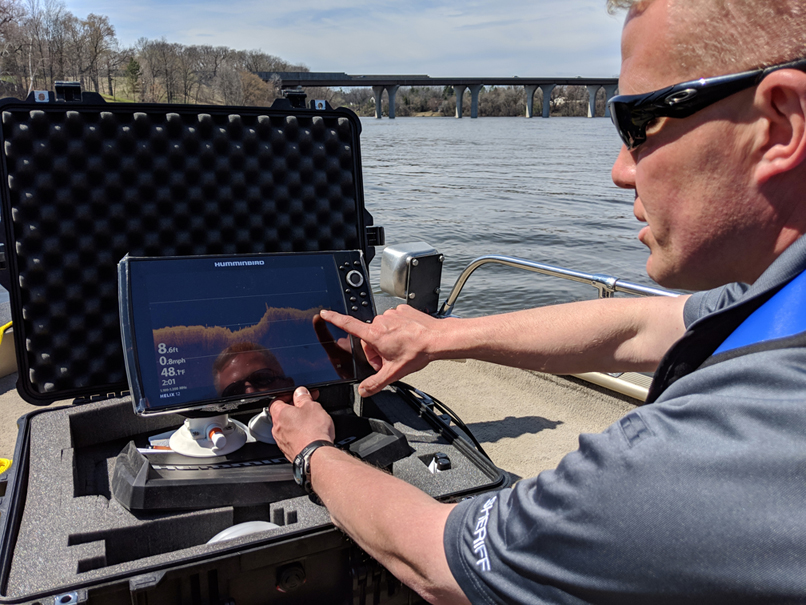Technology upgrade makes job easier for law enforcement
By Scott Bellile
To the untrained eye, the shapes dotting the screen of the Humminbird Helix 12 sonar equipment are brown and black blobs.
But Outagamie County Sheriff’s Deputy Michael Duven knows how to interpret the digital display and assess what’s hidden below his boat. During a demonstration of the imaging equipment on the Fox River April 24, he points out the tire of a submerged bicycle, and minutes later, the legs of a mannequin lying in the riverbed.
The mannequin and bike were planted for a training exercise at Sunset Park in Kimberly, where the sheriff’s office hosted seven rescue agencies from Wisconsin and Minnesota to test their new state-of-the-art sonar technology.
The Helix 12, Duven said, will allow the county’s boat patrol to locate human bodies or criminal evidence such as weapons and stolen valuables more quickly.
The sheriff’s office’s previous sonar computer was 10 years old, so deputies heavily relied on the eyeballs of divers for initial sightings.

Scott Bellile photo
“With the sonar here, we can kind of just make our search patterns up and down the river and pick out maybe one, two, three objects that we’re like, ‘Ah, maybe this might be something [for] the divers to go in and look at,’” Duven said. “And we’ll send a diver down to look at that object instead of making him or her do a huge search pattern and wasting a lot of air, potentially exposing themselves to a lot of hazards.
“The last thing we want to do is have somebody go down to recover that object and be jumping into a bunch of nets or a bunch or rebar or something like that that we can’t see on the surface,” Duven added. “But with the sonar, you can see exactly what’s underneath there and exactly what you’re jumping into.”
Short for “Sound Navigation and Ranging,” sonar is the method of sending sound waves underwater to determine objects’ positions and map what lies below, according to the National Oceanic and Atmospheric Administration.
When law enforcement put sonar to practice during water searches, they study images of the sediment on their computer monitor and watch for formations that appear out of place, Duven said.
“Obviously a car’s looking different on the [river] bottom versus a rock,” Duven said. “And so we’re just trying to pick that out on the sonar and then make different passes at different angles to try and make sure that that’s the object you’re looking at.”
This process of repositioning the boat to capture the object from a better angle can be tedious, Duven said.
Even knowing the approximate locations of the bike and mannequin – they were marked by buoys during the training exercise – Duven had to ask his driver to turn the boat around and pass by the objects again to get them to appear on his computer monitor.
“We’re learning how to use the technology before we need to use it,” Duven said, “and so we want to be as prepared as we can for the big call.”
Duven said the Outagamie County Sheriff’s Office conducts rescue or recovery efforts in the water about six times per year.
Sonar was deployed once so far this year in an attempt to locate the fishing pier on the Wolf River that vanished in Shiocton. Someone eventually found the pier over a mile away from the search zone.
Prior to upgrading its sonar, sheriff’s deputies recently sent a diver into the Fox River to retrieve a handgun that had been used in an attempted homicide in Appleton. Deputies also assisted the Waupaca County Sheriff’s Office in recovering guns from the Embarrass River that had been used in a New London area burglary.
“But we didn’t have the sonar at that time, so it was kind of the old-school way of putting the boat in the water and doing an arc pattern and doing search patterns with a bunch of boats,” Duven said. “So we’re hoping that in the future it gets much easier for us.”
The sheriff’s office owns one sonar computer for its two patrol boats. These computers cost $2,500 to $3,000 each, so the sheriff’s office is applying for a grant in hopes of buying a second one, Duven said.
